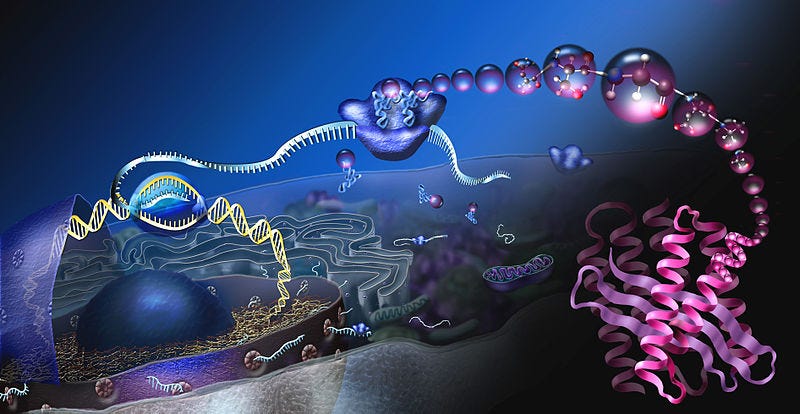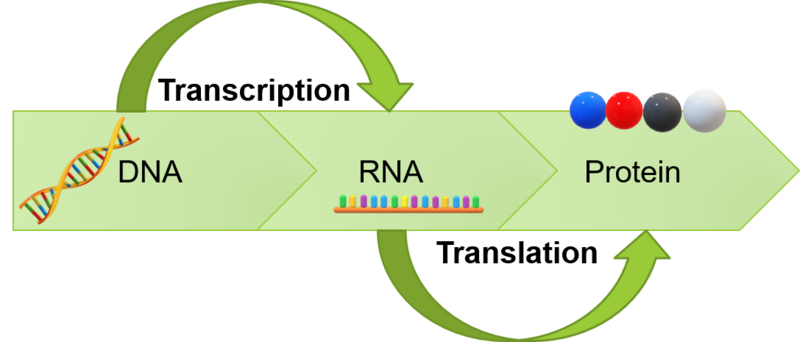Understanding DNA Damage and Its Role in Aging
Written on
Chapter 1: The Impact of DNA Damage on Aging
DNA damage associated with aging disrupts transcription processes, leading to significant issues in vital aging pathways.

In a eukaryotic cell, DNA located within the nucleus is transcribed by RNA polymerase, subsequently enabling ribosomes in the cytoplasm to synthesize amino acid chains that eventually fold into functional proteins.
Understanding DNA Mutations
Every cell in the human body holds a complete set of DNA, representing your genome, with the exception of mature red blood cells and specific cells in hair, skin, and nails. The majority of DNA resides in the cell nucleus, while smaller amounts are located in mitochondria. Specific DNA sequences, known as genes, code for proteins. These sequences undergo transcription to messenger RNA, which is then translated into amino acid sequences that form proteins.

However, DNA is not infallible. Replication errors can occur, be inherited, or arise from environmental influences, resulting in mutations. Some mutations are detrimental and can lead to diseases, but others, such as a recently discovered mutation, may provide protection against conditions like Alzheimer’s disease.
As we age, mutations accumulate due to prolonged exposure to environmental stressors like pollution and UV radiation, alongside the increased likelihood of replication errors over time. Our bodies possess various mechanisms to correct these errors, and the efficiency of these mechanisms appears to correlate with longevity; for instance, some centenarians have gene variants that enhance DNA repair capabilities.
The Consequences of DNA Damage
One clear consequence of DNA damage is the production of faulty proteins. Moreover, issues within the DNA sequence can impede the transcription process, which is crucial for converting DNA into messenger RNA.
Research indicates that aged brains in rodents and fruit flies exhibit reduced production of messenger RNA, accompanied by greater variability in transcription across different tissues. Additionally, transcriptional coordination diminishes with age, although it remains uncertain if the accumulation of DNA damage significantly impacts transcription during normal aging.
#### Insights from Recent Research
Recent studies have examined transcriptional changes in older mice through RNA sequencing to determine if alterations in DNA affect transcription rates and gene activity.
The findings indicate:
- Aging is linked to decreased transcription rates, primarily due to stalled processes, resembling a molecular traffic jam.
- Gene promoter activity remains unaffected, suggesting that the initial transcription signal is intact; however, subsequent steps face disruption.
- Longer genes experience more severe transcriptional delays, which adversely affect critical pathways such as nutrient sensing, autophagy, proteostasis, energy metabolism, immune function, and resilience to cellular stress.
- These transcriptional delays are widespread, impacting various organs, with the liver being the most significantly affected.
Researchers propose that the accumulation of internal DNA damage with age induces transcriptional stress, influencing age-related gene expression profiles across multiple organs and tissues.
Is this phenomenon also applicable to humans? While further research is necessary, preliminary evidence suggests a correlation, particularly in Alzheimer’s disease, where longer genes tend to be expressed less.
The Need for Enhanced DNA Repair Mechanisms
In conclusion, understanding the role of DNA damage in aging is crucial. Improved mechanisms for DNA repair and maintenance may hold the key to mitigating the effects of aging on cellular functions.
Thank you for reading! Connect with me on Twitter, and subscribe to Thinking Ahead for more in-depth explorations of ideas.
Chapter 2: Insights from YouTube
This video, titled "How does DNA age and how do we rejuvenate DNA?" offers an insightful look into the processes underlying DNA aging and potential rejuvenation strategies.
The second video, "Epigenetics and Aging: The effects of DNA breakage and repair," delves into the relationship between DNA damage and aging, emphasizing the importance of repair mechanisms.